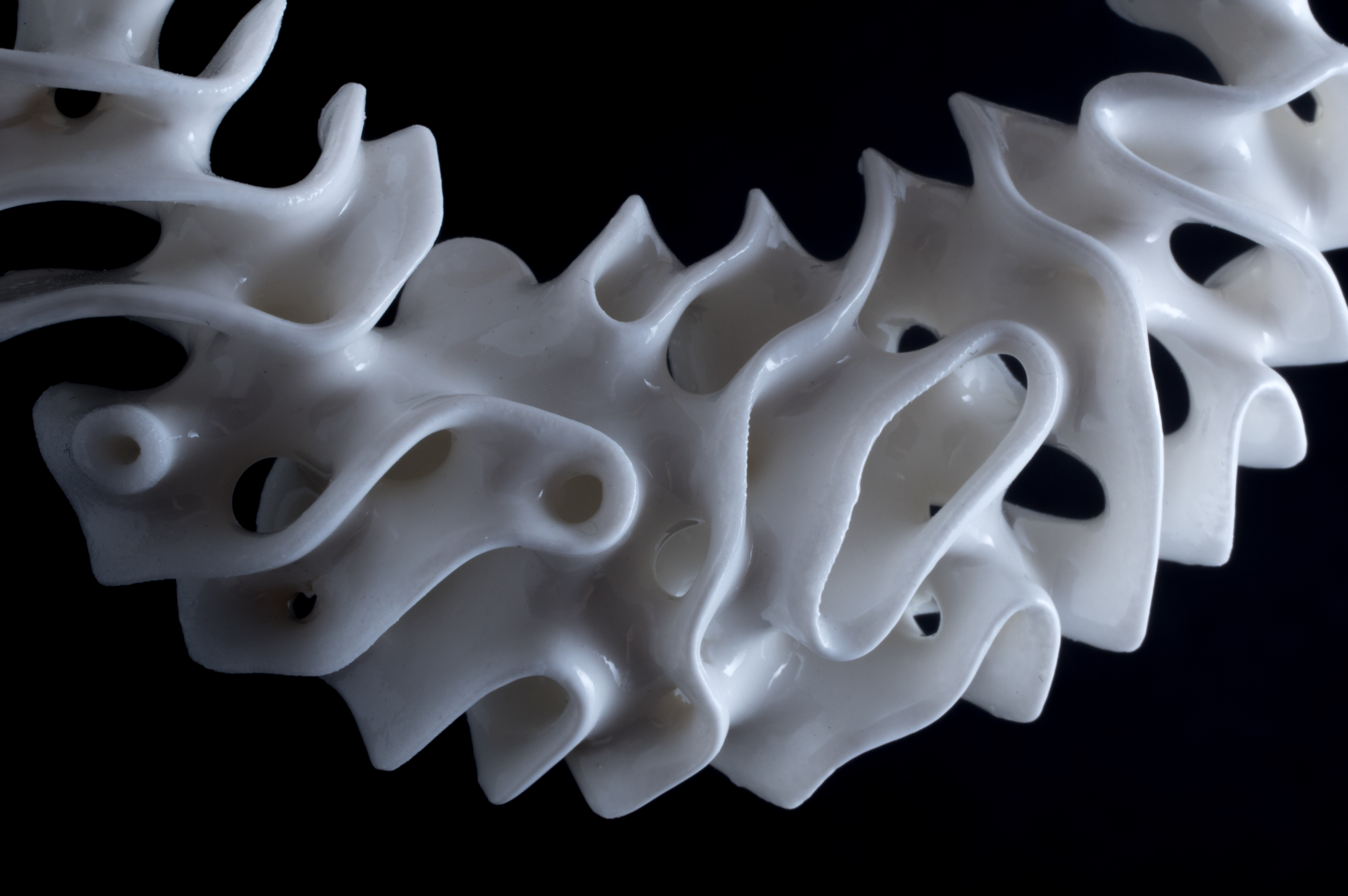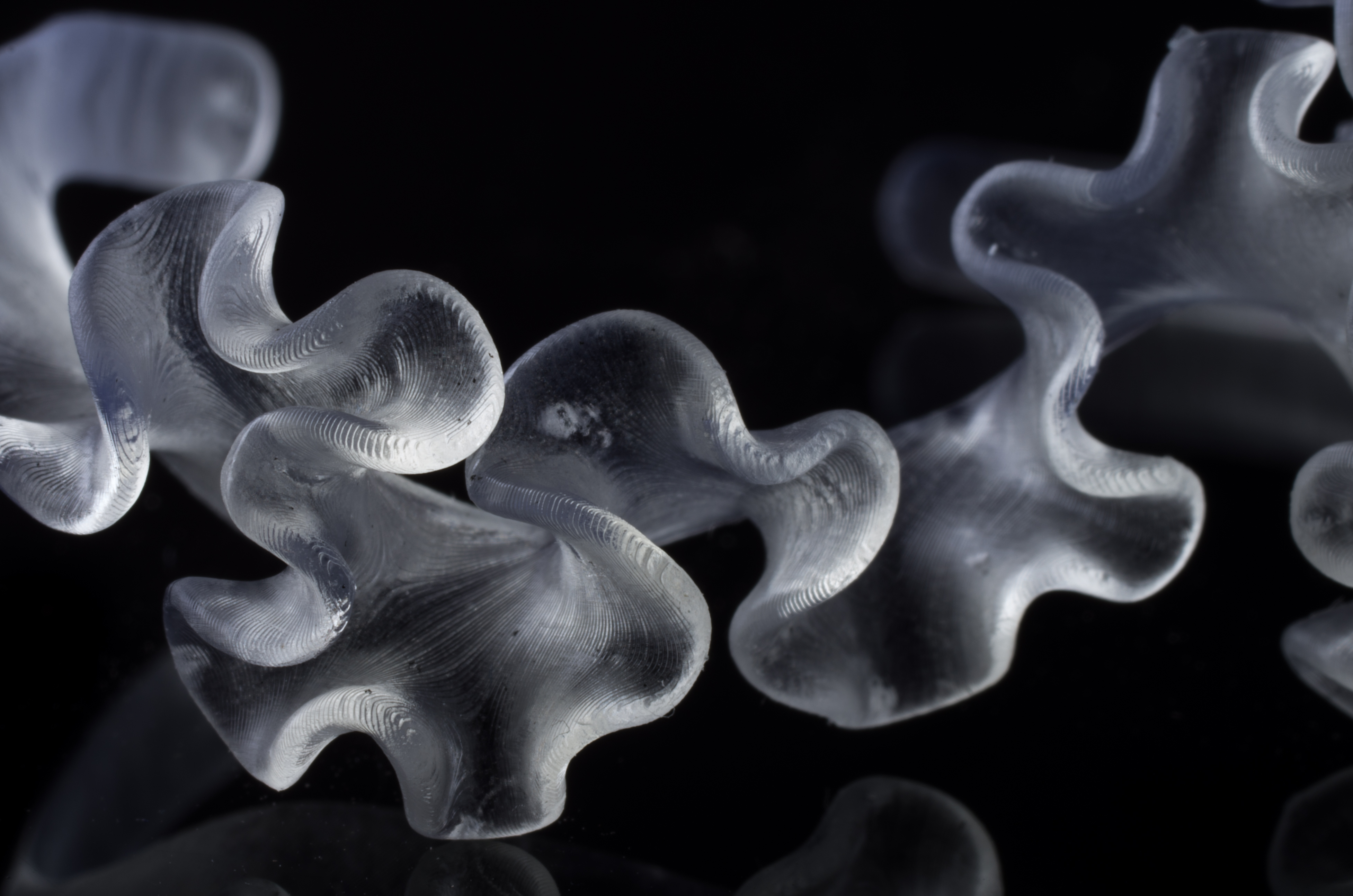Loading 3D models in WebGL
For a new app we’re working on, we finally came upon the task of loading external 3D geometry. I wanted to store and load meshes with as little bandwidth and processing as possible. I’m sure this has been done before, but here is how I approached it.
Rather than loading a mesh in a common file format (eg stl or obj), processing it, and putting into arrays that I could send to a gl buffer, I wanted to load binary data that could go directly to the GPU. So I created a binary representation of a mesh that exactly mirrors the data I would send to an array buffer. It is a list of 32-bit floats representing the vertex data (6 for each vertex with position and normals) followed by a list of 16-bit integers representing triangle indices. Obviously, this is not a very general file format, but it is exactly the data I need for the shaders I was using. The only additional data is two integers at the start of the file representing the number of vertices and faces.
This data can be directly fetched with an http request as an ArrayBuffer object. This ArrayBuffer can be accessed by creating a Float32Array for the vertex data and Uint16Array for the index data. I don’t even have to allocate new storage. Both the vertex and index arrays use the same ArrayBuffer, just with different offsets.
This is surprisingly simple, and the hard work really comes in encoding the mesh data to begin with. This was in fact extra tricky because I had to deal with endian issues. Endian refers to the order in which the bytes of a number are read. Little-endian means the least significant byte comes first, and big-endian means the most significant byte comes first. When you create a TypedArray from an ArrayBuffer, it just sees a list of bytes and it doesn’t know what byte order they are in. Javascript assumes it is the same as the underlying system architecture, which can vary. It turns out the majority of common systems (x86, x86-64, IOS) are all little-endian. So I generally feel I can ignore big-endian systems and just make my files little-endian. However, Java, with which I was generating the meshes, creates big-endian numbers by default. This caused me much grief for a few hours, as everything was working fine except for the fact that my numbers were mysteriously gibberish.
Below you can find the code I used for encoding and decoding the meshes. The AJAX portion is largely copied from an online example.
Processing code for encoding an obj in binary
String folder = "SOMEFOLDER";
String file = "filename.obj";
ArrayList<PVector> srf = new ArrayList<PVector>();
ArrayList<PVector> norm = new ArrayList<PVector>();
ArrayList<int[]> faces = new ArrayList<int[]>();
void setup() {
noLoop();
}
void draw() {
loadSrf(folder+file);
writeSrf(folder+file.substring(0,file.length()-3)+"vbo");
exit();
}
void loadSrf(String name) {
srf.clear();
norm.clear();
faces.clear();
println("LOAD " + name);
String[] lines = loadStrings(name);
for(int i=0;i<lines.length;++i) {
if(lines[i].length() > 2) {
//vertices
if (lines[i].substring(0,2).equals("v ")) {
float info[] = float(split(lines[i], " "));
srf.add(new PVector(info[1],info[2],info[3]));
}
//normals
else if(lines[i].substring(0,2).equals("vn")) {
float info[] = float(split(lines[i], " "));
norm.add(new PVector(info[1],info[2],info[3]));
}
else if(lines[i].substring(0,2).equals("f ")) {
String info[] = split(lines[i], " ");
//sometimes obj's have different indices for different properties separated by '//'
int info1[] = int(split(info[1],"//"));
int info2[] = int(split(info[2],"//"));
int info3[] = int(split(info[3],"//"));
//obj has 1 based indexing and we need 0 based indexing
faces.add(new int[] {info1[0]-1,info2[0]-1,info3[0]-1});
}
}
}
}
//write the data in binary
void writeSrf(String name) {
try {
DataOutputStream dos = new DataOutputStream(new FileOutputStream(name));
dos.writeInt(srf.size());
dos.writeInt(faces.size());
PVector v;
for(int i=0;i<srf.size();++i) {
v = srf.get(i);
writeFloat(dos,v.x);
writeFloat(dos,v.y);
writeFloat(dos,v.z);
v = norm.get(i);
writeFloat(dos,v.x);
writeFloat(dos,v.y);
writeFloat(dos,v.z);
}
int[] f;
for(int i=0;i<faces.size();++i) {
f = faces.get(i);
writeShort(dos,f[0]);
writeShort(dos,f[1]);
writeShort(dos,f[2]);
}
dos.close();
} catch(Exception e) {
}
}
//write a float value little endian
void writeFloat(DataOutputStream dos, float f) throws IOException {
int i = Float.floatToIntBits(f);
dos.writeByte(i & 0xFF);
dos.writeByte((i >> 8) & 0xFF);
dos.writeByte((i >> 16) & 0xFF);
dos.writeByte((i >> 24) & 0xFF);
}
//write a 16-bit integer little endian, integers larger than 65535 will get truncated
void writeShort(DataOutputStream dos, int i) throws IOException {
dos.writeByte(i & 0xFF);
dos.writeByte((i >> 8) & 0xFF);
}
javascript file for loading meshes from a file
//load mesh object
/*
bytes 0-3 = number of vertices
bytes 4-7 = number of faces
vertex = 6x4 bytes position followed by normal
faces = 3x2 bytes as unsigned 16 bit indices
*/
function loadVBO(url, vbo) {
var xhr = new XMLHttpRequest();
xhr.onreadystatechange = function () {
if (xhr.readyState == xhr.DONE) {
if (xhr.status == 200 && xhr.response) {
loadBuffers(xhr.response,vbo);
} else {
console.log("Failed to download:" + xhr.status + " " + xhr.statusText);
}
}
}
// Open the request for the provided url
xhr.open("GET", url, true);
// Set the responseType to 'arraybuffer' for ArrayBuffer response
xhr.responseType = "arraybuffer";
xhr.send();
}
//read ArrayBuffer into gl buffers
function loadBuffers(buffer, vbo) {
var reader = new DataView(buffer);
//get number of vertices and faces
var numVertices = reader.getUint32(0);
var numFaces = reader.getUint32(4);
vbo.numVertices = numVertices;
vbo.numFaces = numFaces;
//put that data in some arrays
vbo.vertexData = new Float32Array(buffer,8,numVertices*6);
vbo.indexData = new Uint16Array(buffer, numVertices*24+8, numFaces*3);
//push that data to the GPU
vbo.vertexBuffer = gl.createBuffer();
gl.bindBuffer(gl.ARRAY_BUFFER, vbo.vertexBuffer);
gl.bufferData(gl.ARRAY_BUFFER, vbo.vertexData, gl.STATIC_DRAW);
vbo.indexBuffer = gl.createBuffer();
gl.bindBuffer(gl.ELEMENT_ARRAY_BUFFER, vbo.indexBuffer);
gl.bufferData(gl.ELEMENT_ARRAY_BUFFER, vbo.indexData, gl.STATIC_DRAW);
}
And to draw the data
function draw() {
//... some gl drawing stuff up here
gl.bindBuffer(gl.ARRAY_BUFFER, vbo.vertexBuffer);
gl.vertexAttribPointer(shaderProgram.vertexPositionAttribute, 3, gl.FLOAT, false,24,0);
gl.vertexAttribPointer(shaderProgram.vertexNormalAttribute, 3, gl.FLOAT, false,24,12);
gl.bindBuffer(gl.ELEMENT_ARRAY_BUFFER, vbo.indexBuffer);
gl.drawElements(gl.TRIANGLES, vbo.numFaces*3, gl.UNSIGNED_SHORT, 0);
}




Marius Watz
Nice tutorial, thanks for posting. Any chance of GitHub / downloadable example?
Jesse Louis-Rosenberg
Thanks Marius! Will definitely consider putting it on GitHub, though I still haven’t managed to start using it internally yet. We’re going to start trying to post regularly on a variety of different topics, so an organized set of examples would be useful. See also my secret course from three years ago: http://n-e-r-v-o-u-s.com/education/simulation/
Nervous System – explorations in generative design and natural phenomena » Blog Archive » The Making of Kinematics
[…] them into Kinematics where users can interactively change them. We’re also expanding and refining tools we created before for loading and working with meshes in […]